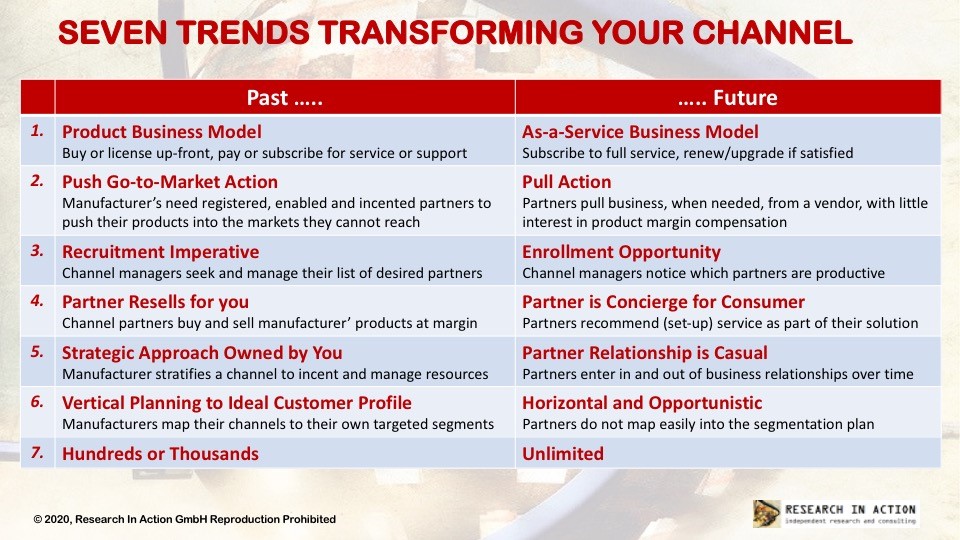The Pandemic is Changing Everything: What Changes Will Stick?
The author of this piece is Peter O’Neill, Research Director at Research in Action, which is a leading independent technology research and consulting company providing both forward-looking and practical advice to enterprise as well as vendor clients. O’Neill is also a member of the ImpartnerChannel Chief Advisory Board (CCAB). The CCAB is a group comprised of top channel thought leaders, analysts, and consultants who each have decades of channel experience and insights to contribute to channel best practice discussions.
Last winter (BEFORE Covid-19), I fielded a global survey asking 1500 manufacturers/vendors about their channel marketing and enablement projects. We asked about their investment drivers, giving 15 options. 1500 ranked “involving partners in our own digital marketing programs” as #6 in their priorities – so already a top priority. In discussions with channel partners themselves, I find that this item is even more important to them, and I expect that trend to continue in the future, as digital business truly dominates marketing, selling, and business relationships.
The survey also showed that businesses now prefer a more comprehensive channel management software platform that covers all of their needs – partner marketing, management, and even sales. Currently, most partner management vendors focus on either channel marketing or enablement only. But manufacturers will seek a channel platform that can support a highly-volatile partner community through a much more complete business cycle, from connection to order processing and service delivery… a quite different partner management world.
How different and why?
I see this transformation under seven separate trend headlines with all these aspects of channel management moving, over time, from the left-side state to the emerging state described on the right-side.

For decades channel enablement and marketing were just a peripheral process in most industries; the mantra was: “first we sell direct and then we’ll find some partners.” Most firms were selling physical products (or at least on-premises software) and just needed knowledgeable sellers to position the offer to buyers they couldn’t reach.
But now…almost every industry is morphing to an “as-a-service” business model. And buyers pull the service based on their own research. But heh! Channel partners are not being “dis-intermediated” — this was such a strange cliché back in the 1990s when the Internet took hold and everybody was writing about eBusiness and eCommerce taking work away from channel partners. If anything, the channel has become even more influential and advocational for businesses. The business model in the channel has changed too and they’re more than likely to live off revenues earned from the end-user than from the manufacturer they now occasionally represent. In addition to resellers or distributors, we now have channel players called affiliates, referrers, associations, communities, groups, and ambassadors.
In fact, just as we like to talk about customer-centric or buyer-led purchasing, the partners are now taking control of the partnerships they need to maintain with vendors. From push to pull. Vendors can no longer map out their target markets and plan partnerships around the battlefield like generals ordering armies around a warzone. The market, the partner communities, run the new game.
This is not only the case in the tech industry. Consider a leading manufacturer of industrial bearings, Sheaffler Group in Germany. They’ve found that their new sensor technology creates a whole set of opportunities as an Internet-of-Things data provider. The sensors they’ve installed in trains, combined with AI technology, can provide vital maintenance data on the railway track itself, which is sold to the Bundesbahn who maintain the infrastructure. Schaeffler continues to be a manufacturer but now also has a data service business with new partnerships. As-a-Service is happening everywhere.
That is the bigger picture and most trends are the result of changing expectations on the buyer side and the proliferation of digital channels across all businesses and industries. It has been the fact that digital transformation has been somewhat held up in certain countries and industries due to the classical resistance to change. COVID-19 has burned away many of those hurdles. Hardly any executive or HR manager will now claim that WFH is bad for business. Companies have learned quickly to continue most of their business relationships both internally and externally through digital media.
Here are the most important other trends I believe are here to stay:
- An optimized experience. The business imperative will become “Provide the Optimal Customer Experience.” Manufacturers will need to ensure that their channel partners are part of that experience and therefore need to provide customer insights to them.
- More effective tools. Partner management platforms will help manufacturers to manage thousands of partners of all types without making 80% of them feel inadequate because they are only a silver-tier partner and do not warrant personal attention.
- Better enabled Partners. There is an even larger boom in sales enablement investments at the moment. Clearly, sellers now interact with buyers digitally, remotely and the signs are that buyers like this new behavior and will prefer it to become permanent. They will focus on those suppliers who have the capability to support them. As I tell every client I talk to: “Channel enablement must be part of the sales enablement program.”
The current crisis has created a sort of perfect storm for sales and channel enablement projects and that is a change that I think will outlast COVID-19 and become a strategic imperative in many companies over 2021 and beyond. Those channel enablement and marketing platform vendors who can cover the needs described above will flourish in this marketplace.
To learn how to stay ahead of these trends, watch the full webinar I presented with Impartner CMO Kerry Desberg, where I dive deeper into the channel research I mentioned, along with each of these trends. If you have questions on how to better manage partners through a partner relationship management platform to increase channel revenue, visit impartner.com/demo.
